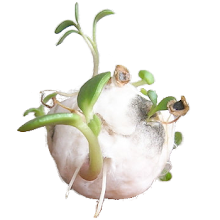The pitfalls: Unfortunately, my plantable paper can't go through a printer. I know that a couple of my customers have successfully printed on my papers but I haven't. I have a very old printer that is fussy. But even if it were not, my papers have some very chunky seeds in them that not only would catch in a printer and rip the paper but might also do a lot worse to your printer. So I don't recommend it.
The reason you can write on my papers is because I recycle paper that was initially manufactured to allow for writing, like card stocks, junk mail, etc. That means that when the paper was made, an internal sizing was added to the slurry (or paper pulp). Sizing is used to improve the strength, stiffness, smoothness or weight of a paper or to control its absorbency. In other words, it seals the paper so you can write on it without the ink bleeding and feathering.
So I decided to try a little experiment with as many different kinds of inks as I could find. I went down to my local arts supplies store. (Shout out in Soave Faire in Saratoga. They allow customers to try any pen they sell, so I brought a piece of my plantable paper into the store and tried everything! Huzzah!)

For the most part, every ink worked well, which actually surprised me. I tell my customers not to use inks that are overly watery, like calligraphy ink, but I had decent success with the Varsity Disposable Fountain Pen (the purple ink on the largest piece of paper). It worked well when I wrote quickly but did bleed into thick lines when I wrote the word "pen" very slowly. The Buffalo marker was a thick marker (the light blue ink on large piece of paper), like one a child would use. I didn't like that one, probably because it doesn't have enough ink to transfer well - perhaps because it is intended for coloring. The only hiccup was from the calligraphy pen (red ink on large piece of paper) because I hit a big seed in the paper that had caused a divot. I even had success with an erasable gel pen as well as a pencil.
I hope that is helpful! To get back to my Etsy shop, go here: https://www.etsy.com/shop/PulpArt
Want to know about sizing in a more scientific analysis? Here you go:
http://www.diva-portal.org/smash/get/diva2%3A12738/FULLTEXT01.pdf


No comments:
Post a Comment